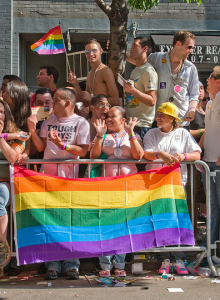What Do Gay Rights And The Environment Have In Common?
 By Claire Morgenstern, La Onda Verde
By Claire Morgenstern, La Onda Verde
I’m having a case of movement envy.
This past weekend I marched in NYC’s annual Gay Pride Parade with my friends atGLAAD (Gay & Lesbian Alliance Against Defamation)—my first time attending Pride since 2005. As we made our way down Fifth Avenue from 40th Street to Washington Square Park and over to Christopher Street, I was blown away by what a difference seven years makes. The parade was bigger, louder and more colorful than I ever remembered.
Here at NRDC we’re in the business of not just taking to the courtroom when we see something wrong, but building powerful movements for change. So I watched with great interest the hoards and hoards of people from every walk of life that lined the streets for miles, cheering and crying and waving their flags, I thought—what’s it’s going to take to create this kind of passion, this kind of transformation in the environmental community? Not to mention this kind of stellar turnout for a parade?
In my book, the gay rights movement and the environmental movement—both causes in which I’ve been very involved since high school—actually have a lot in common. Like the gay rights movement, we in the environmental movement are engaged in an epic fight for equality for all living things on Earth. Some of us are fighting for a better future for those we love. Others of us are fighting for the right to keep on loving something (or someone) that we’ve already grown to love so much. Regardless, we’re two groups of people who are deeply devoted making the world a better place—and two groups of people who are profoundly worried about what will happen to that world if we fail.
Here’s the difference. The gay rights movement is a personal movement. It’s driven by personal stories. It’s the Boy Scout leader in Ohio who was kicked out for being gay. It’s the couple of fifty years that was finally able to get married in New York State. It’s the friends and families of gay men and women who just want their sons and daughters and neighbors and community members to have the same chance of finding happiness in life as their heterosexual counterparts. These are the stories that give people a place, a personal stake in a movement that’s so much bigger than themselves.
These are the stories that we must create in the environmental movement. This movement is not just a group of policy experts sitting in a boardroom (though we do plenty of that). It’s not even just those of us who came together last week for the Rio+20 Earth Summit. It’s Sheila Holt-Orsted, a Tennessee woman who, after a nine-year battle,secured access to safe drinking water and protection from toxic well water for her community. It’s the parents of children with asthma who worry about what will happen to their kids if the air pollution in their cities and towns gets worse. It’s the NRDC members who speak out in public hearings across the country to oppose a project, whether it’sseismic oil and gas exploration or construction of a massive gold and copper mine, that would wreak havoc on the environment where they live.
Our job is not just to fight those battles, but to communicate those stories to as many people as we can. It is our hope that this power of storytelling will inspire countless others to seek their own place in this movement, their own connection to the world outside their doors and the people they share it with. Only then will we be able to stand up and march.
La Onda Verde, Switchboard, is the staff blog of the Natural Resources Defense Council, the nation’s most effective environmental group.
[Photo by See-ming Lee]
